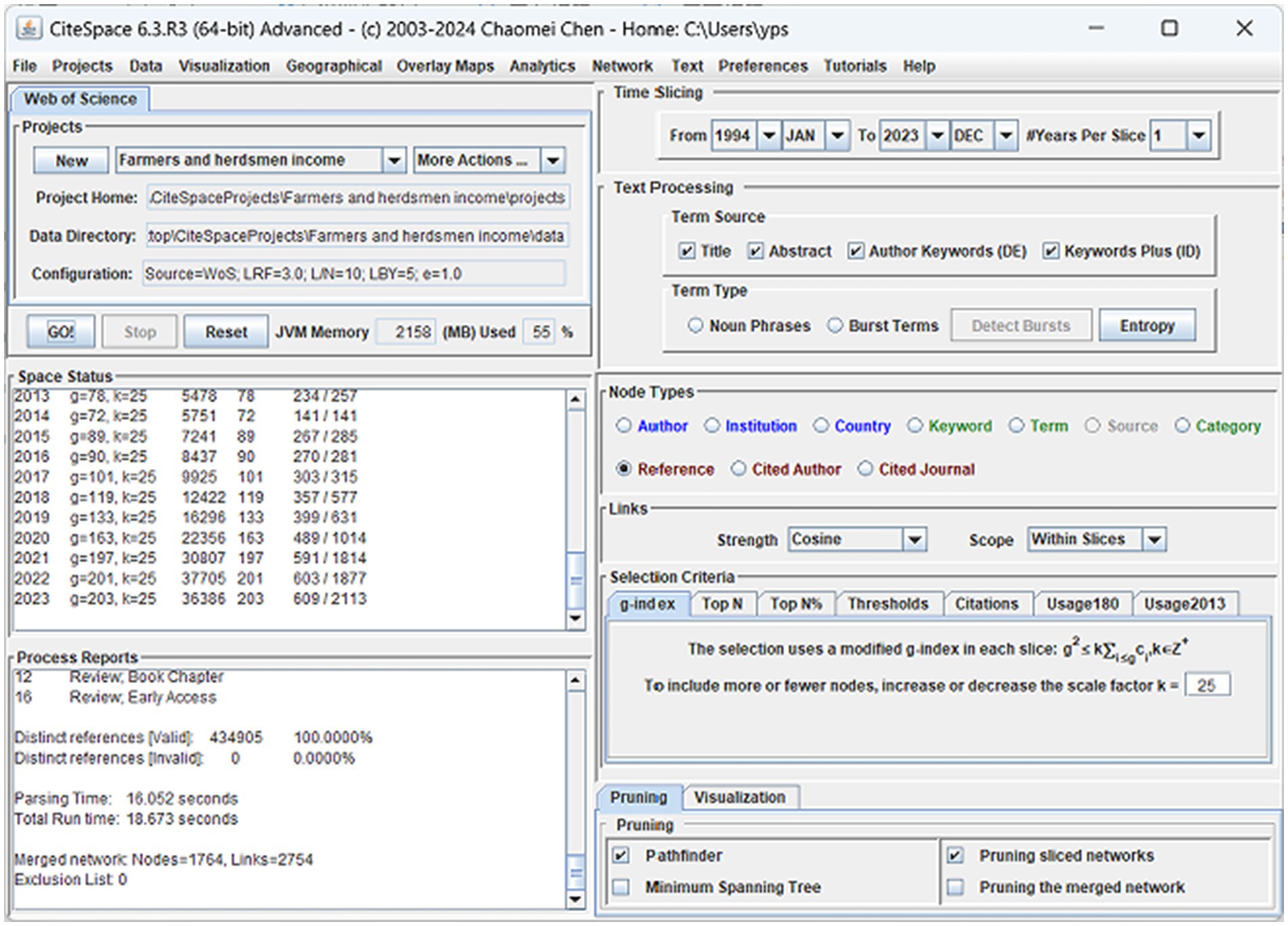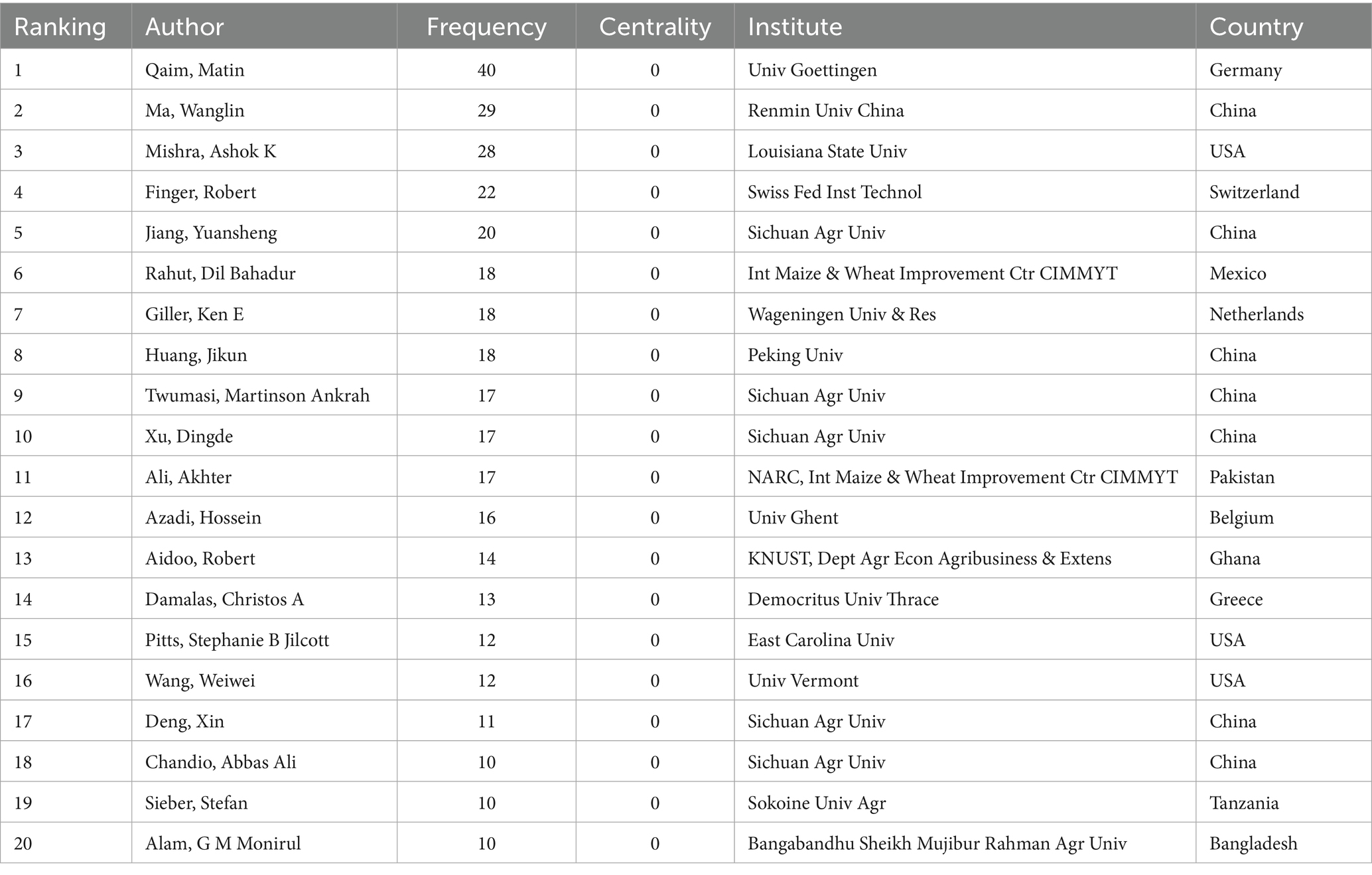- 1Department of Teaching, Gansu Open University, Lanzhou, China
- 2College of Fine Arts and Design, Lanzhou University of Arts and Science, Lanzhou, China
- 3Shaanxi Construction Technology Institute, Xi'an, China
- 4College of Agricultural Economics and Management, Shanxi Agricultural University, Taiyuan, China
- 5Gansu Digital Learning Resource Center, Library, Gansu Open University, Lanzhou, China
- 6College of Pastoral Agriculture Science and Technology, Lanzhou University, Lanzhou, China
The income of farmers and herdsmen is directly related to the prosperity and harmony of the entire society. Improving the income of farmers and herdsmen not only affects the living standards of individuals and families but also impacts the sustainability of society and the economic development of the country. To gain a global understanding of the research hotspots associated with the income of farmers and herdsmen, the study used the CiteSpace software to analyze the research publications and references on the income of farmers and herdsmen published between 1994 and 2023 and available in the Web of Science. The data collected included countries, institutions, journals, authors, keywords, co-citations, research focus and frontiers. The data showed a total of 14,726 literature, with the number of publications increasing significantly in 2013, and continuously from 2015 to 2022. The research hotspots focused on management and agriculture policy, land use and food systems, rural development, conservation and biodiversity. Most of the researches was involved the countries or district of developing countries in Africa and Asia. While the research levels include agricultural technology, climate change, sustainable development and policy at different scales. However, the research frontiers and trends focused on sustainable development, climate change, food security, agricultural techniques and policies. The present study provides knowledge and comments for further research on the global income of farmers and herdsmen.
1 Introduction
Agriculture practice is the basis of human society that plays a crucial role in food production and livestock breeding and serves as an important foundation for ensuring global food security (Yang et al., 2019; Li et al., 2020; Wawrzyniak, 2023). The continuous growth of the global population exerts significant pressure on food demand (Lipper et al., 2014), making the sustainable development of agriculture and animal husbandry essential for meeting the basic human needs. Therefore, improving agricultural production efficiency and enhancing its management techniques can effectively ensure food supply and maintain social stability (Tittonell and Giller, 2013; Abdulai and Huffman, 2014; Li et al., 2021; Yan et al., 2022; Zhao et al., 2024).
The income of farmers and herdsmen, derived from agriculture production, animal husbandry, rural business income, and other sources of income such as subsidies and transfer payments (Sibhatu et al., 2015), reflects their economic conditions and is closely linked to societal harmony and stability. The income of farmers and herdsmen is also an important indicator of rural economic development and sustainability and is influenced by various factors, including market prices, climate change, agricultural technology, and policy support (Jayne et al., 2014; Ali and Erenstein, 2017; Zhong et al., 2024). Fluctuations in market prices directly impact the income of farmers and herdsmen, while the supply and demand relationship between agricultural products, seasonal changes, and regional differences often leads to price instability, which exposes farmers to significant risks (Evans et al., 2012; Fischer and Qaim, 2012; Horst and Gwinb, 2018; Collins, 2020; Gulwako et al., 2023).
Climate change further affecting productivity through rising temperatures, and increased frequency of extreme weather events (Bryan et al., 2013; Abid et al., 2015; Nahar et al., 2018; Kramer and Hackman, 2023). While modern agricultural technologies can enhance production efficiency, reduce costs and increase income to the farmers and herdsmen. However, the dissemination and accessibility of technology vary across different regions, and some farmers struggle to improve their income due to a lack of technical support (Abdulai and Huffman, 2014; Wossen et al., 2017). Additionally, government policies, including subsidies, insurance, and financial services, play a crucial role in mitigating and risks and increase income. However, inadequate policy implementation or lack of transparency in certain areas can exacerbate income inequality (Antle and Capalbo, 1994; Jayne et al., 2014; Brown et al., 2021).
Despite the growing of researches on farmers’ and herdsmen’s income, much of papers focused on specific factors or regions (Bryan et al., 2013), often overlooking the complex interplay of various influences. Most of the studies tend to isolate individual variables, such as market access (Collins, 2020), climate conditions (Abid et al., 2015), or technological advancements (Abdulai and Huffman, 2014), lack of considering the interactions of these factors. This narrow focus leads to an incomplete understanding of the multifaceted challenges that farmers and herdsmen face in different contexts. Additionally, much of the existing literatures is concentrated in specific regions, such as farmers’ perceptions of and adaptation strategies to climate change and their determinants in Pakinstan (Abid et al., 2015), adapting agriculture to climate change in Kenya (Bryan et al., 2013), food standards, certification, and poverty among coffee farmers in Uganda (Chiputwa), land access for direct market food farmers in Oregon, USA (Horst and Gwinb, 2018). These limitation may not be representative of global trends. This lack of comprehensive analysis limits the applicability of findings across diverse agricultural systems and socio-economic conditions. Furthermore, the methodologies employed in previous studies often rely on traditional statistical approaches that may not adequately capture the dynamic nature of income variability. For instance, Sibhatu et al. (2015) examines how production diversity among smallholder farmers affects dietary diversity and the role of market access, while Abdulai and Huffman (2014) explores the factors influencing the adoption of soil and water conservation techniques by African farmers, as well as the impact of these techniques on farm yields and net income. In both cases, the reliance on traditional methods may limit the depth and applicability of the findings, possibly missing critical variations and causal relationships. As a result, critical insights regarding the cumulative effects of multiple factors on income levels remain unexplored. This gap in the literature underscores the need for a more integrative approach that considers the interconnectedness of various influences on farmers’ and herdsmen’s incomes. To address these shortcomings, this study aims to fill the gap by providing a holistic analysis of the factors affecting income variability among farmers and herdsmen globally.
CiteSpace is a literature visualization and analysis software developed by Professor Chen (Kumar et al., 2023; Pang et al., 2022). It analyzes citation relationships and keyword co-occurrences in literature to reveal research dynamics and development trends in scientific fields. CiteSpace has powerful data processing and visualization capabilities, enabling researchers to intuitively understand the knowledge map of their research area and discover potential research hotspots and future topics (Pang et al., 2022; Kumar et al., 2023). Therefore, the present study used CiteSpace software (version 6.3 R3) to visualize and analyze the “articles” and “Reviews,” on the global income of farmers and herdsmen published in the Web of Science (WOS) Database from 1994 to 2023. The present research will identify current trends and hotspots in the field, synthesize findings from diverse regions and contexts, offering valuable insights for policymakers and stakeholders, to promote sustainable agricultural practices and improve the livelihoods of rural communities by highlighting the complex interactions that shape income dynamics in farming and herding systems.
2 Materials and methods
2.1 Data sources
The Web of Science database1 was used to retrieve the literature on the income of farmers and herdsmen from 1994 to 2023 using the “Advanced Search Query” as the retrieval method.
2.2 Methods
The CiteSpace software was employed to visualize and analyze the literature concerning the income of farmers and herdsmen, utilizing data from the Web of Science Core Collection Database (WOSCC) (Figure 1). The search strategy focused on the topics “farmers” or “herdsmen” in conjunction with “income.” The document types included both “articles” and “reviews,” specifically in English. A comprehensive search yielded a total of 14,726 relevant literature pieces.
The dataset comprised information such as the names of countries, institutions, authors, journals, co-cited references, and keywords. This extensive dataset was subsequently analyzed to create a visual map, facilitating the exploration of connections within the literature. The time parameters for the analysis were set from 1994 to 2023, allowing for an examination of trends over the past three decades.
For visual map creation, methodologies such as pathfinder and pruning sliced networks were applied to effectively clip the networks and enhance clarity (Pang et al., 2022). These techniques helped in condensing the data into manageable and comprehensible visual representations. To assess the current status of research related to farmers and herdsmen, as well as to identify emerging hotspots, trends, and future directions in the field, we utilized the entire set of 14,726 literature pieces without further narrowing the dataset. This inclusive approach ensured a comprehensive understanding of the existing research landscape.
3 Results
3.1 Literature distribution
The descriptive statistics were conducted on the number of relevant research literature from 1994 to 2023 (Figure 2). In total, 14,726 WOSCC database articles related to the income and occupation of the farmers and herdsmen were counted. The research on the income and occupation of herdsmen in the WOSCC database shows a slow increase in the number of articles from 1994 to 2006, and a rapid increase since 2014. The increase may be linked to global agricultural challenges or policy changes that have spurred research interest. The number of publications rose significantly from 473 to 1,826 annually between 2015 and 2022, indicating that this topic has become a focal point in agricultural research. However, the majority of studies are concentrated in developing countries, particularly in Africa, China, and Indian, which highlights a gap in the literature regarding income dynamics in diverse global contexts.
3.2 Co-occurrence analysis of countries and institutions
The study used the country node of CiteSpace to visualize the WOSCC literature related to the income of farmers and herdsmen from different research countries and institutes (Figures 3A,B). The network map constructed by WOSCC literature had a total of 174 nodes and 2,466 connecting lines for countries and 873 nodes and 3,016 connecting lines for institutes, with 0.1638 and 0.0079 as the density of the cooperative network of countries and institutes, respectively. The visual analysis showed that the number of literatures published by the United States of America (USA) was much higher than other countries, with a centrality of 0.09, and China with a centrality of 0.07. A higher centrality value indicates closer collaborative relationships with other countries within the international scientific research network (Table 1). Thus, The USA and China have wider international cooperation, suggests the two countries plays a pivotal role in international research collaborations. Among the top 10 institutions with the most published papers, four institutes were found in China, three in the USA and two in the Netherlands, with Chinese Academy of Science (Chinese Acad Sci), Wageningen University (Wageningen Univ) and China Agricultural University (China Agr Univ) leading the research publications on the income of farmers and herdsmen (Table 1; Figure 3). The predominance of Chinese institutions reflects the country’s significant investment in agricultural research. This was approved by China’s Poverty Alleviation Victory in 2020. Despite the high numbers of research output, the low level of international collaboration suggests a missed opportunity for cross-regional insights that could enhance understanding of income variability among farmers and herdsmen.
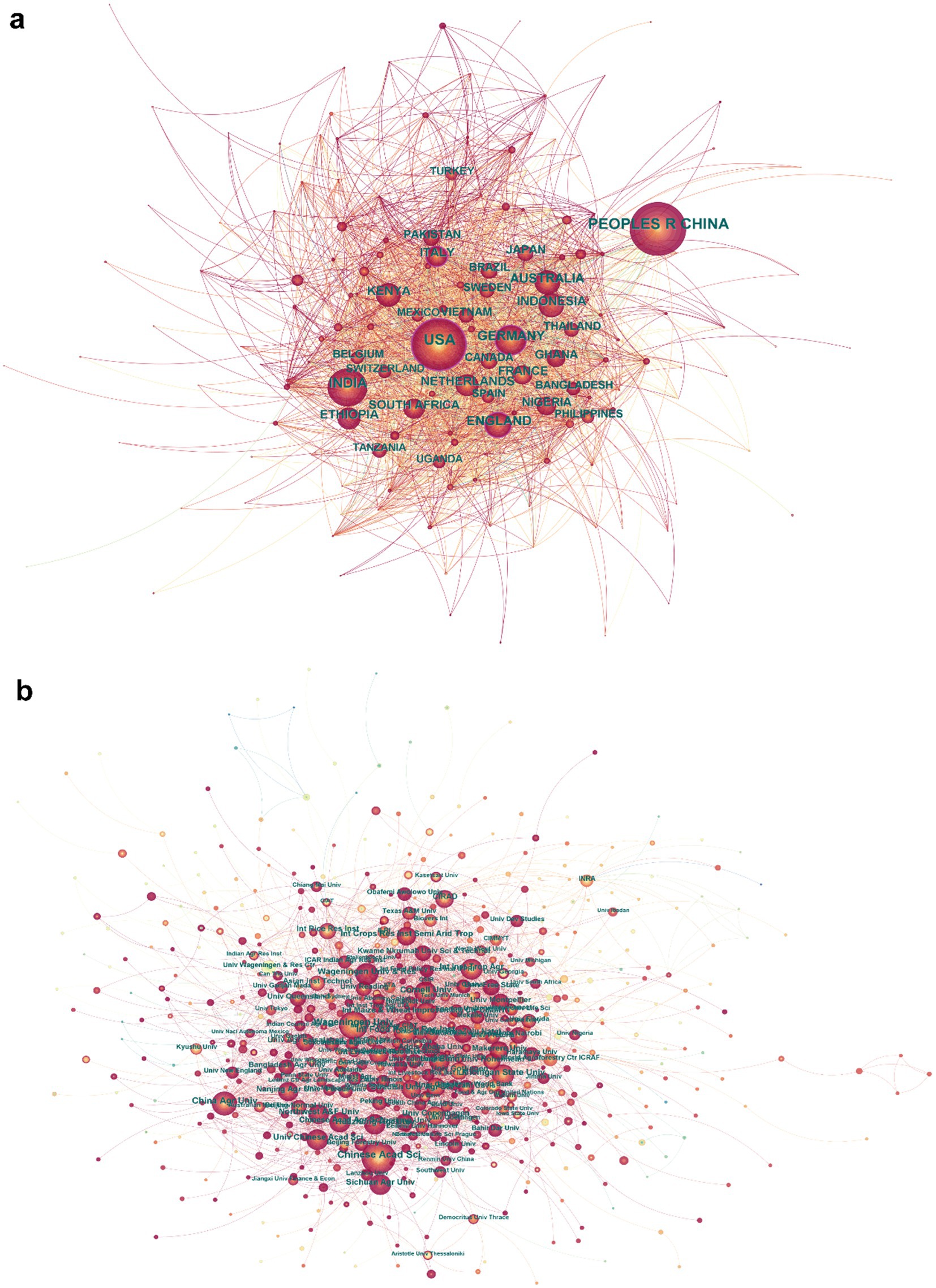
Figure 3. The co-occurrence map of the global income of farmers and herdsmen from different research countries (A) and institutions (B).
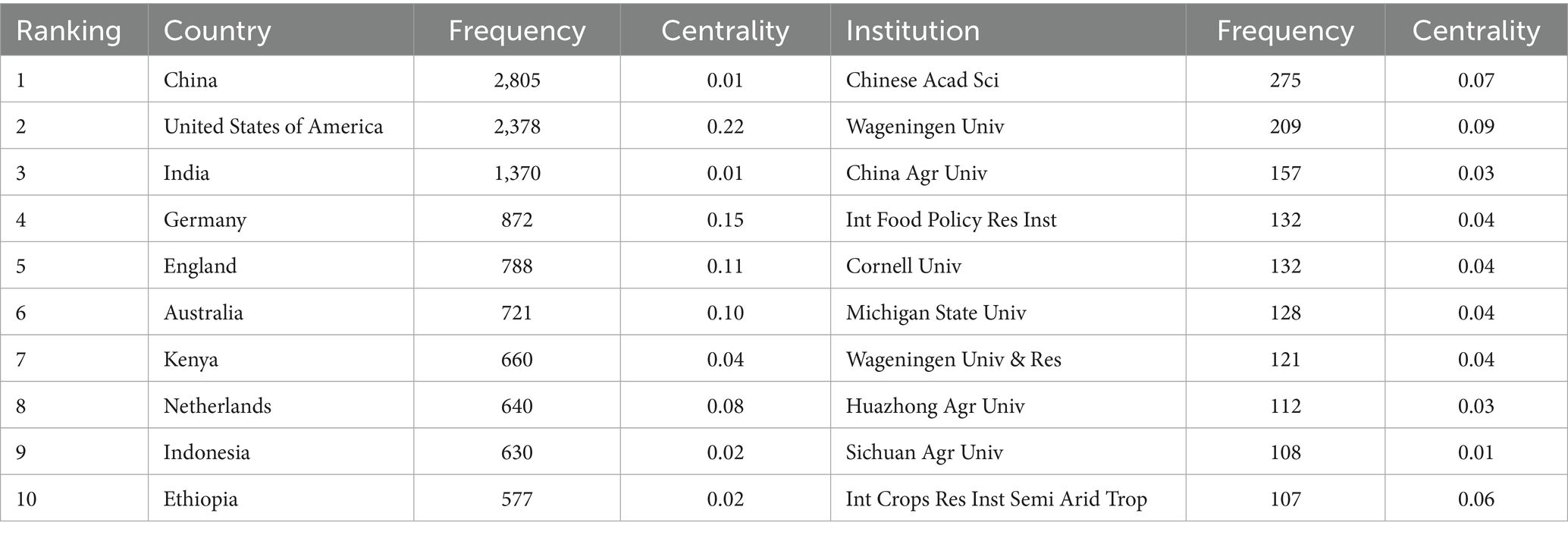
Table 1. Top 10 countries and institutions with the highest number of publications on the income of farmers or herdsmen.
3.3 Analysis of author co-occurrence
The 1,232 authors with the highest number of occurrences were selected for co-occurrence analysis. The network map of the 1,232 authors co-occurrence constructed by WOSCC literature showed a total of 942 connecting lines, with 0.0012 as the density of the cooperative network of countries and institutes (Figure 4A). A high-density representation indicates that the collaboration and citation relationships among authors are relatively close, reflecting a greater number of connections within the network. This typically suggests a strong willingness to collaborate and communicate among researchers in the field, fostering an active research community. The top 20 authors with higher publication volumes had more in-depth research on the income of farmers and herdsmen, ranging from 10 to 40 publications, with a low centrality value for each of the authors (Table 2). The network collaboration map of authors on the income of farmers and herdsmen exhibited an overall scattered pattern featuring collaborative teams represented by Qaim Matin, and Ma Wanglin, among others, with 40 and 29 publications, respectively (Figures 4A,B; Table 2).
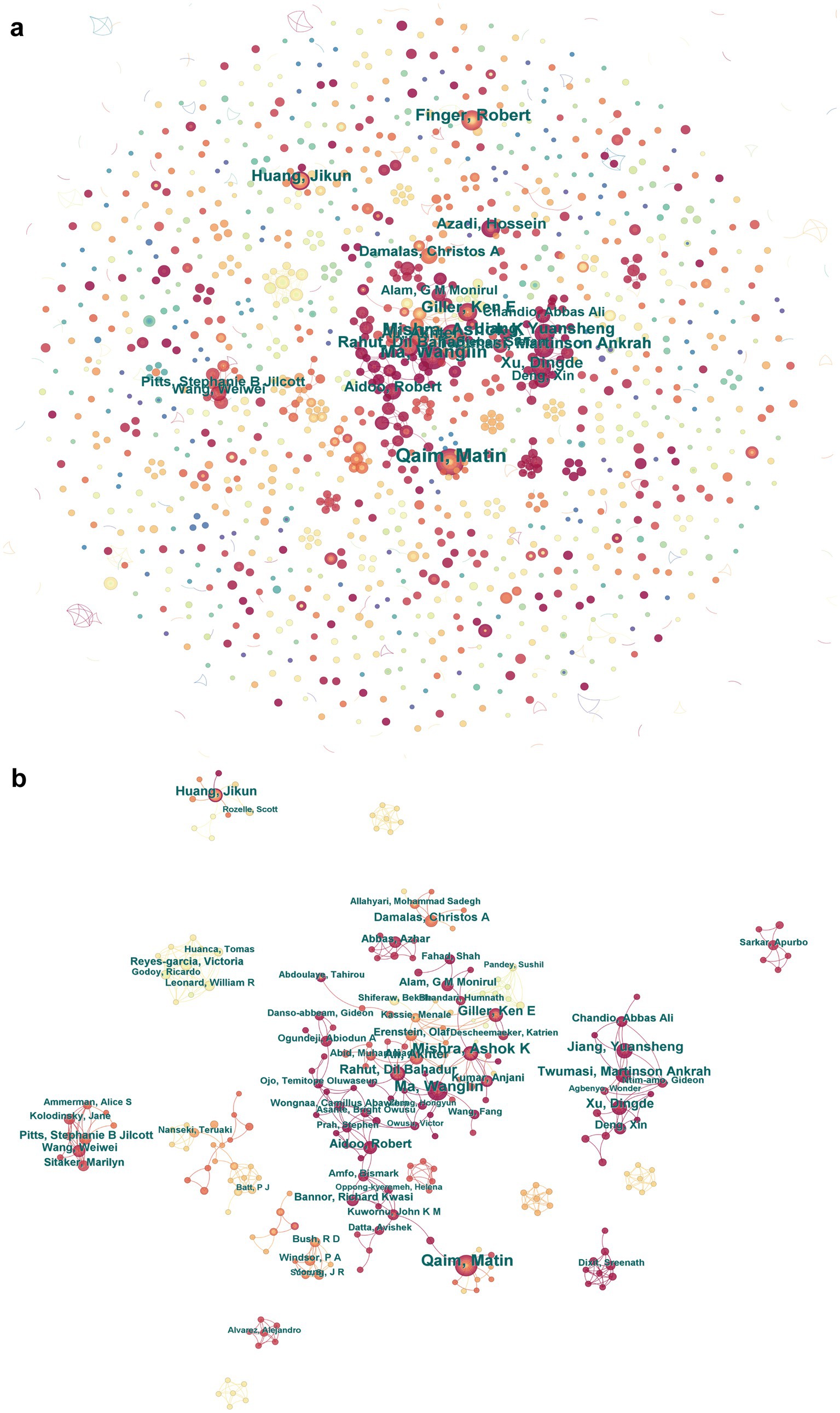
Figure 4. A network map showing the 1,232 co-author collaboration network (A), and the top 20 author co-occurrence researchers (B) working on the fields related to the income of farmers and herdsmen.
Most of the top 20 researchers emphasized the significance of farmers’ knowledge, attitudes and perceptions in markets, food systems, agroforestry innovations, policies and climate change (Meijer et al., 2015; Kelly et al., 2016; Sibhatu and Matin, 2018; Yin et al., 2020; Gever et al., 2021). The researchers also examined agricultural management practices such as soil and water conservation techniques, nutrient availability (Abdulai and Huffman, 2014), crop varieties (Khonje et al., 2015; Nyadanu et al., 2016), expansion of agricultural extension services and farmer cooperative participation on farm yields, net income and poverty reduction of farmers in Africa and China (Chiputwa et al., 2015; Wossen et al., 2017; Ikhuoso et al., 2020; He and Ahmed, 2022). However, the centrality of the authors was zero, indicating the low levels of cooperation between authors, with most scholars conducting independent research (Figure 4B; Table 2). This lack of cooperation may hinder the development of comprehensive strategies to address the multifaceted challenges faced by farmers and herdsmen. The diversity of research perspectives is evident, but the scattered nature of authorship suggests that a more collaborative approach could yield richer insights into income dynamics.
3.4 Analysis of keywords
3.4.1 Analysis of keywords co-occurrence
Analyzing the frequency of keywords can provide insights into the research hotspots in the field of rural income. In the graph, larger nodes indicate more frequent keyword occurrences, while more connections between keywords indicate a closer relationship. By using the CiteSpace software to analyze sample literature from the WOSCC database, a co-occurrence graph with 997 nodes, 10,777 links, and a density of 0.0217 (Figure 5) was generated. Among the nodes, “management” was the largest, followed by “farmers,” “climate change,” “food security,” and “sustainable agriculture.” These keywords appeared most frequently (Figure 5), revealing them as the most current research hotspots and factors that influence the income of the farmers and herdsmen. The identification of the current research trends also emphasizes the profound impact of climate change on agriculture and the importance of enhancing the income of farmers and herdsmen, and food security through smart agriculture, sustainable agriculture and effective management strategies (Janssen and Ittersum, 2007; Bryan et al., 2013; Ali and Erenstein, 2017; Liu et al., 2024). This aligns closely with the agricultural management, market access, food systems, agriculture technological innovation, and climate change addressed in the research of the top 20 authors.
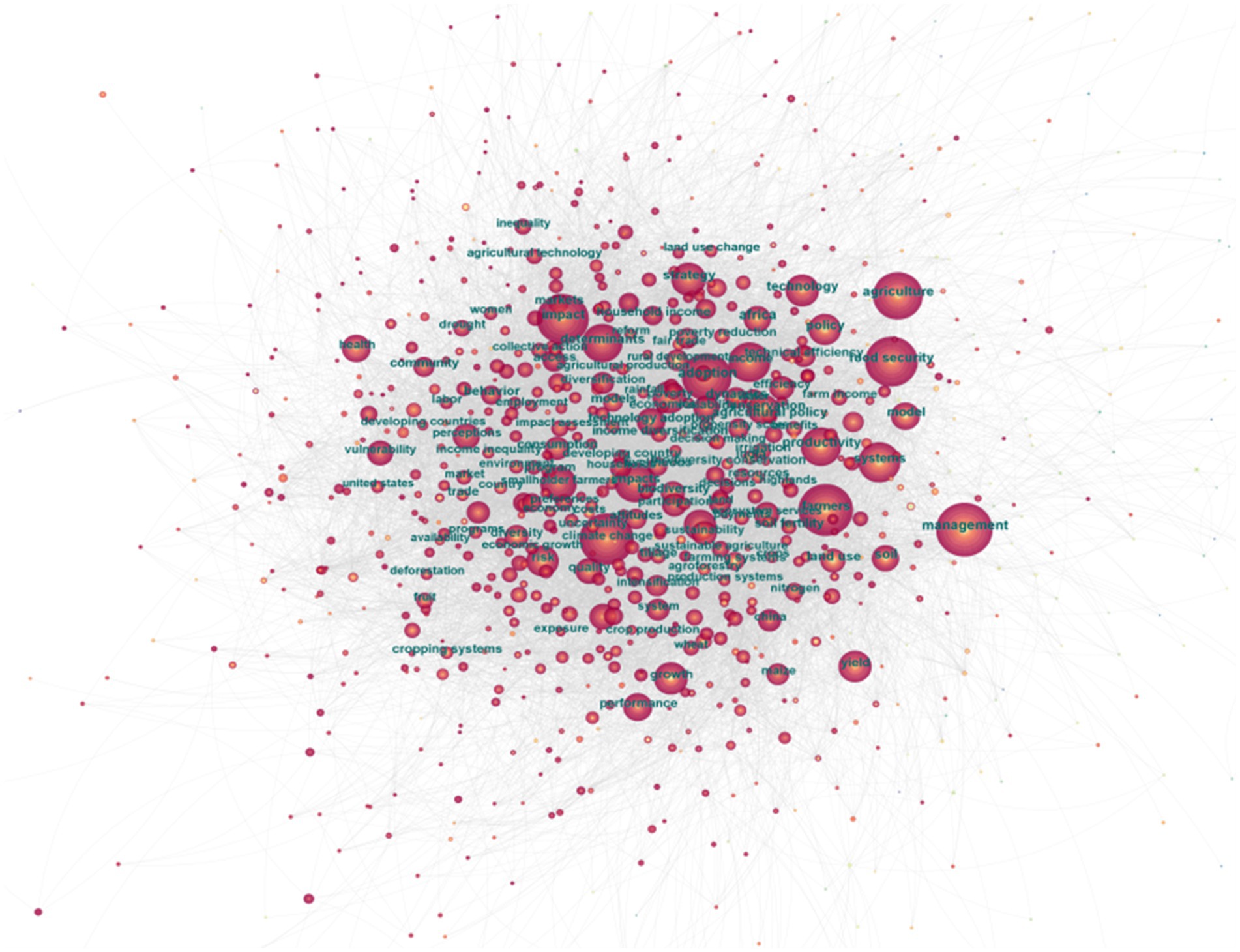
Figure 5. The keywords co-occurrence network map of farmer and herdsmen income from web of science core collection database.
3.4.2 Analysis of keywords bursts
Keyword burst refers to a significant increase in the frequency of keywords appearing within a short period (Pang et al., 2022). Analyzing keyword bursts can provide a clear understanding of research hotspots during a specific time and help determine the direction of research. The greater the strength of keyword bursts the more attention scholars are paying (Pang et al., 2022). Therefore the study used the CiteSpace software to analyze the keyword bursts in the sample data from WOSCC from 1994 to 2023 and obtained the dynamics in the research hotspots associated with the income of the farmers and herdsmen (Figure 6). Based on the changes in the burst word map the research process of income of the farmers and herdsmen is divided into three stages
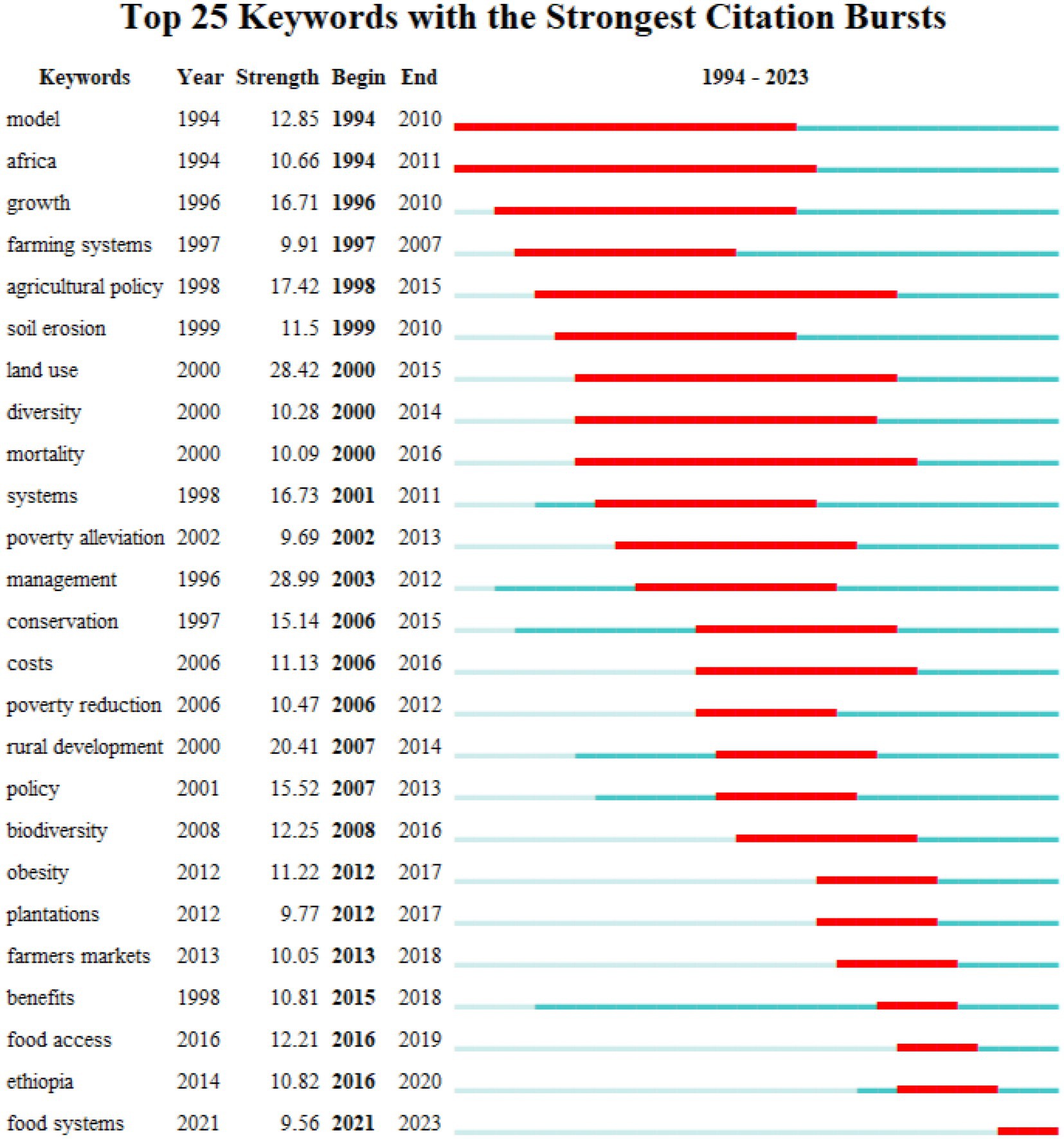
Figure 6. The top 25 keywords with the strongest citation bursts that related to the income of the farmers and herdsmen.
The first stage begins from 1994 to 2000, where the keywords with the strongest burst intensity include “model,” “Africa,” “growth,” “farming system,” and “agricultural policy.” The second stage commences from 2001 to 2008, with “poverty reduction,” “rural development,” and “biodiversity” as the keywords with the strongest burst intensity. The last and third stage starts from 2009 to 2023, where the keywords with the strongest burst intensity are “obesity,” “farmers markets,” “benefits,” “food access,” and “food systems.”
In the past 5 years (2018–2023), the highest cited keyword with high burst intensity was “food access” from the research literature with a strength of 12.21. The period between 2021 and 2023 had the keyword “food system” which was the least cited, consistently maintaining a low interest (Figure 5). Figure 6 recognized as a new international research hotspot in recent years, with related articles primarily focusing on management, agricultural policy (Pietola and Lansink, 2001; Van et al., 2013; Lapola et al., 2014; Wu et al., 2018; Brown et al., 2021), land use system (Zhang et al., 2014; Haider et al., 2017), rural development (Wang et al., 2015; Manda et al., 2016; Middendorp et al., 2018; Li et al., 2022; Long et al., 2022), conservation and diversity (Li et al., 2022; Li et al., 2023), model and food access (Jones et al., 2014; Lowder et al., 2016; Ma and Abdulai, 2016).
The analysis of keyword trends across these stages reveals a significant evolution in agricultural research priorities, shifting from foundational concepts to pressing contemporary issues. The rising prominence of “food access” in recent years highlights its critical role in addressing food security and public health challenges. Conversely, the declining interest in “food systems” suggests a need for renewed focus and exploration in this area, particularly concerning sustainable agricultural practices and policy development. This dynamic landscape of research reflects the continuous adaptation of agricultural studies to meet emerging global challenges and priorities.
3.4.3 Analysis of keywords clustering
In the CiteSpace cluster maps, different colored blocks represent different clusters, and each “#” tag represents a cluster. The Q and S values were used to measure the clustering effect of the map, where Q > 0.3 indicated significant clustering structure, S > 0.7 indicated convincing clustering, and above 0.5 indicated a reasonable clustering. Using CiteSpace to analyze the 1,764-literature associated with the income of farmers and herdsmen in the WOSCC database, the study generated a keyword cluster map (Figure 7). The map had a clustering module value of 0.7797 and an average silhouette value of 0.8952, indicating a significant and highly credible structure of the keyword cluster map. The map had a total of 10 clusters arranged in the order from #0 to #9, with smaller numbers containing more keywords in the cluster. The 10 clusters included the “adaptation strategies,” “transportation infrastructure,” “dietary diversity,” “rural China,” “agricultural cooperative,” “sustainable agricultural intensification practice,” “fair trade cooperative,” “farmers market,” “coffee farmers cooperative,” and “own development” (Figure 7). These keywords exhibit a strong focus on agricultural themes, food security, and dietary diversity, highlighting the importance of these topics in research related to smallholder farming. Farmers from different regions and countries have different responses to global climate change and its challenges. The researchers also incorporate different terms like “farmers,” “policy,” and “climate change” to reflect a response to socio-economic and environmental influences affecting sustainable agriculture and food security.
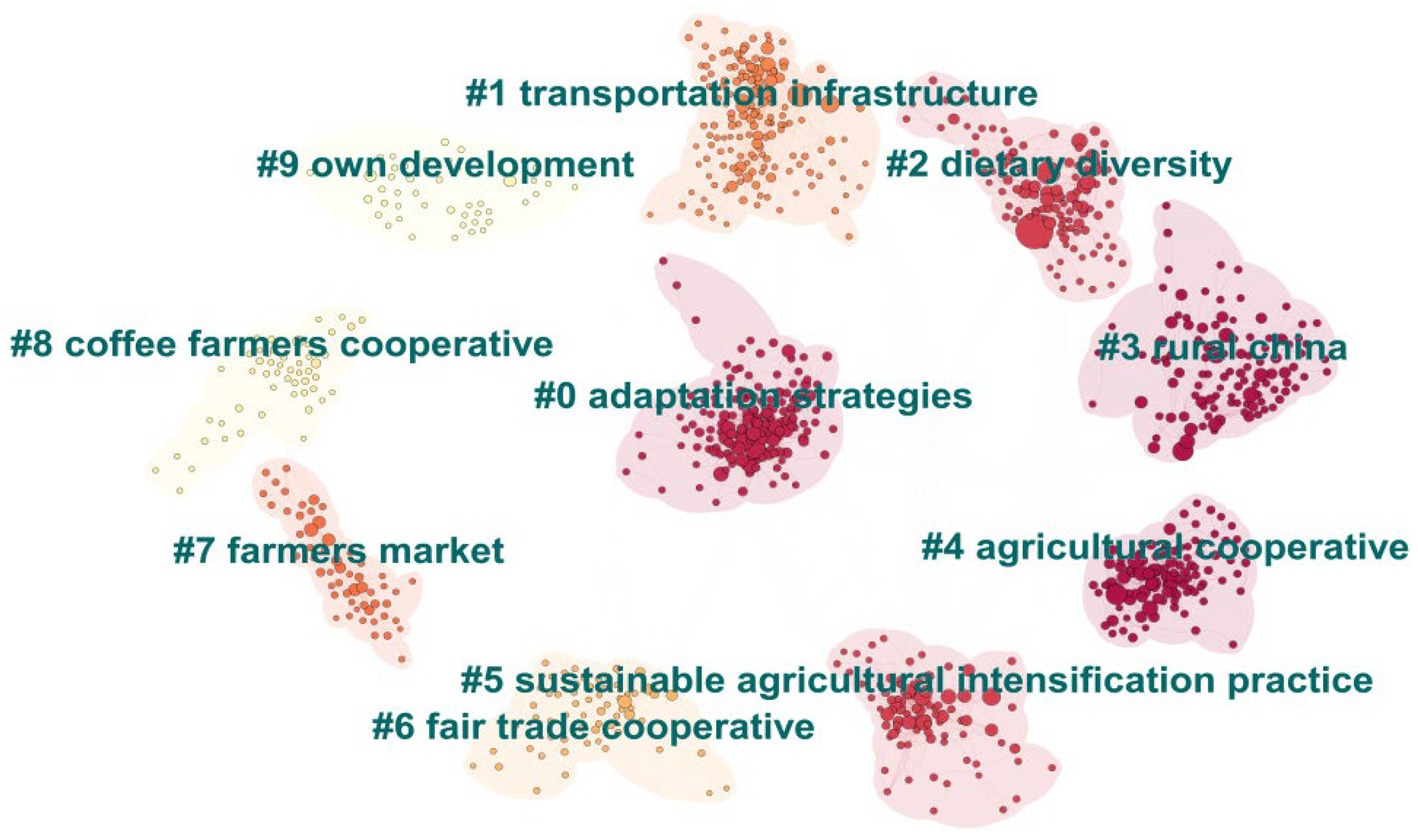
Figure 7. Cluster analysis of the co-cited literature associated with the income of the farmers and herdsmen. The different colored blocks represent different clusters, and each “#” tag represents a cluster.
The study also utilized CiteSpace to visualize the temporal distribution of keywords in the literature associated with the income of farmers and herdsmen in the WOSCC database, with the size of the nodes representing different keyword frequencies. The keywords from 1994 to 2000 mainly included “food security,” “management,” “agriculture,” “income,” “impact,” “systems,” “strategy,” “adoption,” “food security,” “system,” “market,” and “land use,” indicating the primary focus of research during that period. From 2001 to 2008, the main keywords shifted to “policy,” “farmers,” “technology adoption,” “climate change,” “smallholder farmers,” “biodiversity,” and “ecosystem services.” From 2009 to 2023, the main keywords shifted to “participation,” “households,” “service,” “dietary diversity,” “women empowerment,” “food insecurity,|” “rural households,” “innovation,” “climate-smart agriculture (CSA),” “food systems,” “subsidy,” “machine learning,” “energy consumption,” “internet use,” “deep learning,” “happiness,” and “life satisfaction” (Figure 8).
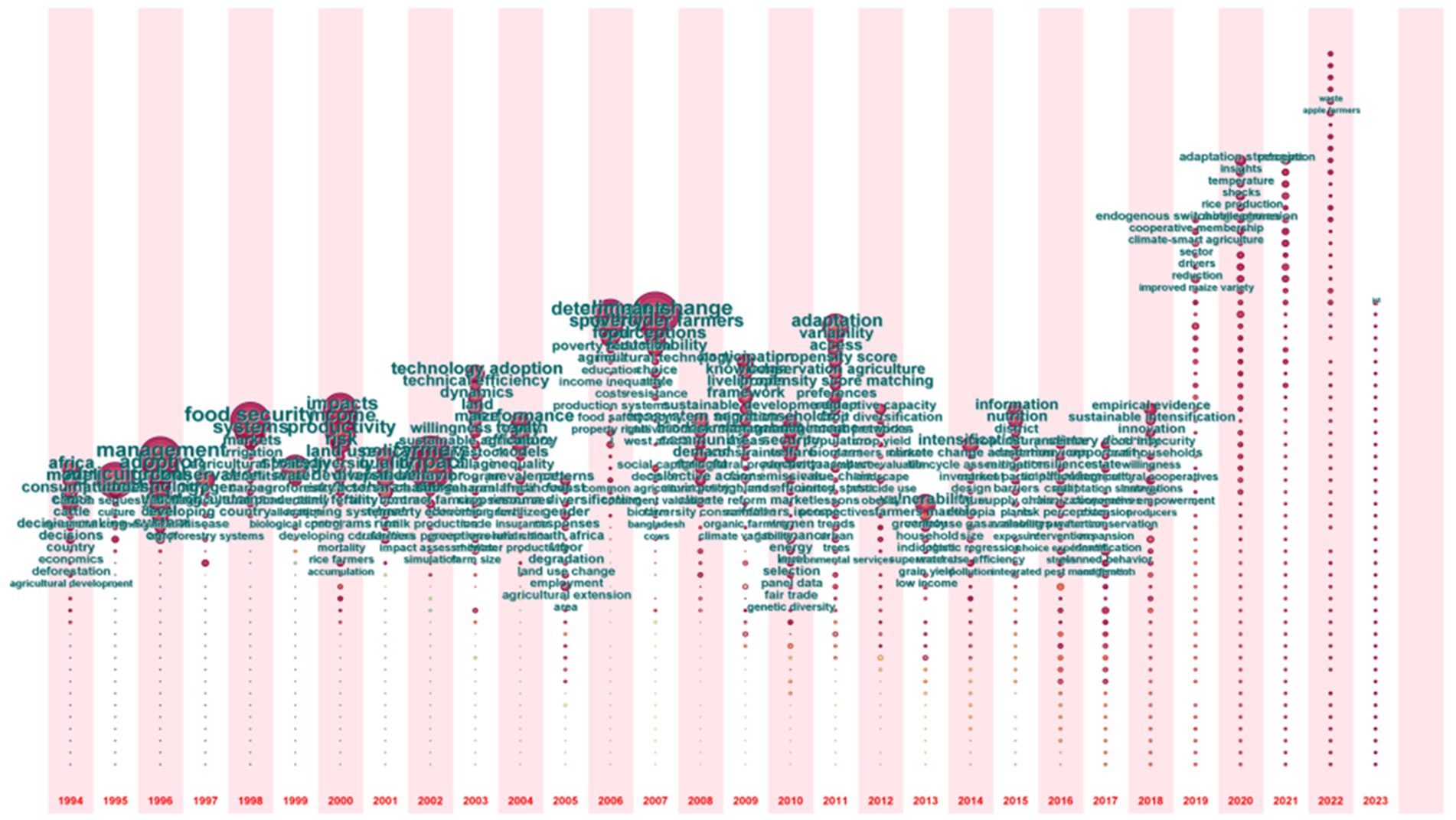
Figure 8. The time zone of the cluster analysis of the income of farmers and herdsmen from web of science core collection database.
Overall, both the keywords burst and keywords cluster analyses reflect a progression in research focus from foundational concepts to contemporary issues The income-related research highlights socio-economic factors and technological influences, whereas the agricultural research maintains a broader focus on food systems and climate and environmental considerations.
3.5 Analysis of the highly cited references
Emerging literature reflects shifts or the rise of research topics within a particular field (Pang et al., 2022). By using the burst detection feature of CiteSpace, the study can identify and highlight literature with potential value in the field of research associated with the income of the farmers and herders. The results of 25 research publications with a burst strength greater than five are presented in Figure 9, showing the burst references and their burst strength, burst duration, and a graphical representation of the burst timeline of each selected reference with the blue and red lines. From Figure 9, the blue timeline shows the ordinary growth of citations, whereas the red timeline indicates the burst growth of citations.
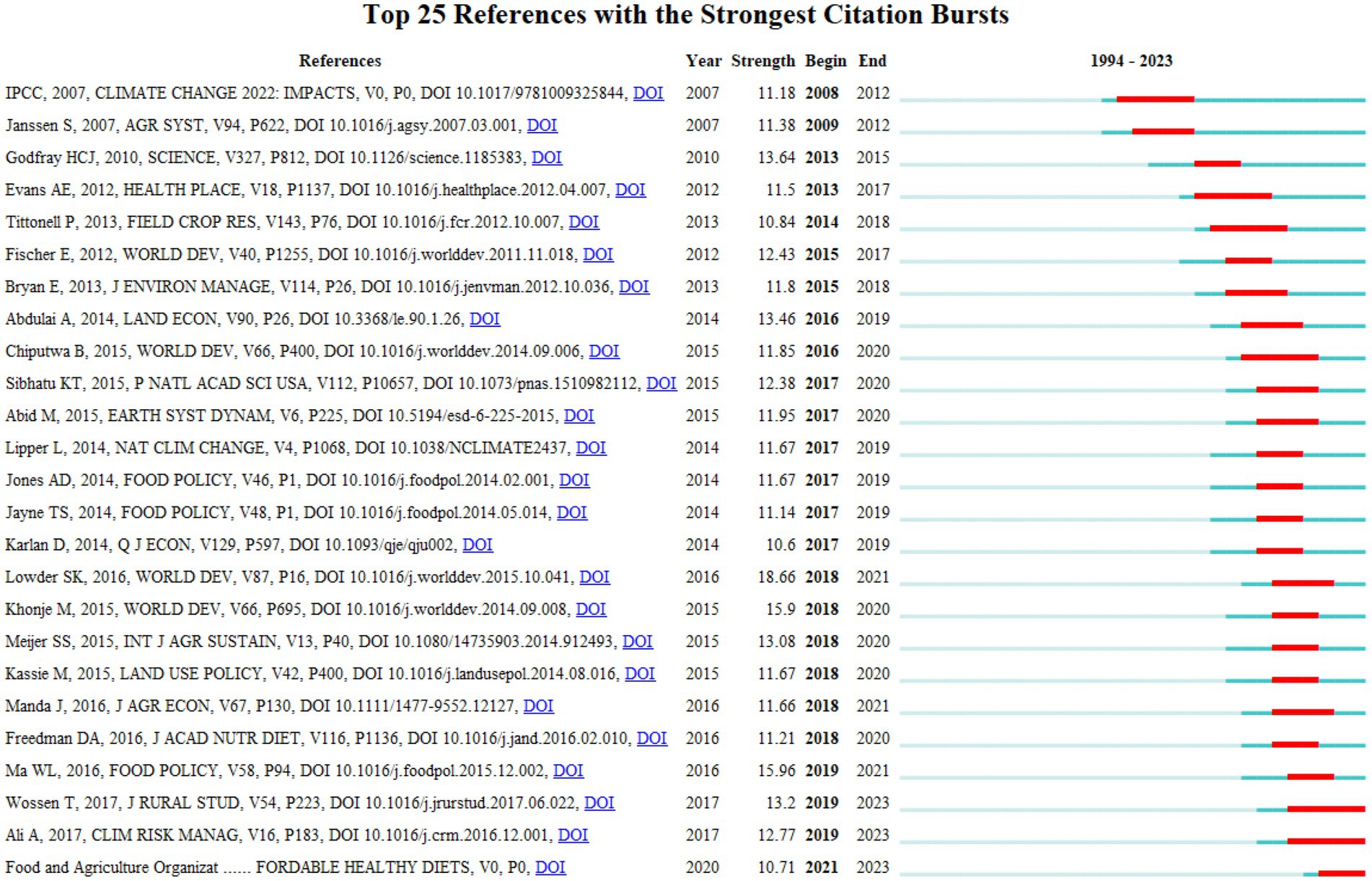
Figure 9. The top 25 references with the strongest citation bursts in the field of farmers and herdsmen income.
Based on the citation burst analysis results (Figure 9), the strongest citation burst of 18.66 was attributed to the “number, size, and distribution of smallholder or family farms” in an article published in the World Development Journal by Lowder et al. (2016). The Lowder et al. article shows that although the average farm size in low-and lower-middle-income countries generally decreased from 1960 to 2000, the average farm size in high-income countries increased, affecting the agricultural management practices and farmers’ income (Karlan et al., 2014). The next highly cited reference article was the Ma and Abdulai (2016) published in “Food Policy Journal,” entitled “Does cooperative membership improve household welfare? Evidence from apple farmers in China” (Koppmair et al., 2016). These authors explored the impact of membership in agricultural cooperatives on the production performance, net income, and household income of apple farmers in China. The research found that the farm size, labor input, and asset ownership influenced the farmers to join the cooperatives, subsequently helping them to improve their apple yield and household and net incomes (Koppmair et al., 2016), suggesting that strategic support for cooperatives and sustainable farm management practices is vital for boosting the livelihoods of smallholder farmers globally.
Climate change poses a serious threat to the global economy, particularly in agricultural production and has been investigated by several researchers. For instance, Bryan et al. (2013) investigated Kenyan farmers’ perceptions of climate change, their adaptation measures, and the influencing factors (Bryan et al., 2013). Abid et al. (2015) found that farmers’ adaptive capacity to climate change in Pakistan is limited by factors such as insufficient information, lack of funding, and strained irrigation water sources (Abid et al., 2015), while Ali (2017) revealed that younger farmers with higher education levels, greater wealth, larger cultivated areas, and joint family structures were more inclined to adopt adaptation measures to climate change. In addition to climate change, Jayne et al. (2014) reviews the profound impact of rising rural population density in Africa on agricultural systems and the economy, emphasizing the extent to which these changes are underestimated in African development. Karlan et al. (2014) explores agricultural investment decisions after the relaxation of credit and risk constraints, with a focus on the behavioral changes of small-scale farmers following the receipt of cash subsidies and rainfall index insurance. The research finds that the lack of insurance risk is a major factor limiting farmers’ investments.
4 Discussion
The findings of present study highlight the increasing recognition of farmers’ and herdsmen’s income as a critical field of research. The significant rise in publications since 2014 reflects a growing awareness of the complexities surrounding farmers and herdsmen income. However, the concentration of research in specific regions, particularly in developing countries, underscores a significant gap in the literature. The USA, China and India are countries with the top research publications, however, the cooperation between countries is low. The research institutions involved in the study of the income of the farmers and herdsmen research are mostly Chinese and Americans, with the Chinese Academy of Science as the institution with the most research publications. This study addresses this gap by providing a comprehensive analysis of the factors influencing income variability among farmers and herdsmen globally.
The low level of international collaboration among researchers indicates a need for more integrated approaches that consider the diverse socio-economic contexts affecting farmers and herdsmen income. The analysis of co-occurrence among authors and institutions reveals that while there are leading contributors, the scattered nature of research efforts may limit the development of cohesive strategies to enhance farmers income stability. Among the top cited authors, Qaim Matin whose research team was recorded as the author/co-authors with the largest number of research papers has conducted in-depth research on the income of farmers and herdsmen and indicated a positive correlation between production and dietary diversity in smallholder households in Indonesia, Kenya, Ethiopia and Malawi (Sibhatu et al., 2015). Further research by a meta-analysis showed that low income and low dietary diversity remain significant issues in many developing countries, with smallholder farmers being widely affected. Among the 45 studies on farm production diversity, only five reported a consistently significant positive correlation, while 60% of the studies showed a moderate positive correlation, which only holds under specific conditions (Sibhatu and Matin, 2018).
Other most cited authors underscores the critical interconnection between sustainable agricultural practices, soil and water conservation, and food security in developing countries, highlighting that addressing biophysical constraints and enhancing farmers’ access to education and resources are essential for improving productivity and alleviating poverty in the face of growing population and environmental challenges. For example, Godfray et al. (2010) discusses the food security challenges posed by the continuous growth of the global population and consumption and emphasizes the importance of implementing sustainable and equitable food production strategies to address climate change and other environmental threats. Tittonell and Giller (2013) explores the widespread yield gap in smallholder agriculture in Africa and its impact on improving agricultural productivity. These authors found that insufficient soil fertility and nutrient unavailability are the main biophysical factors, limiting agricultural production in Africa preventing farmers from benefiting from crop genetic improvements and creating a poverty trap. In another similar research. In contrast, Abdulai and Huffman (2014) found that education level, capital and labor constraints, social networks, agricultural extension connections, and soil conditions were the main determinants of adopting the contour farming technique. Furthermore, the adoption of this technology significantly increased rice yields and net income, indicating that in the water-scarce regions of sub-Saharan Africa (SSA), soil and water conservation techniques are critical for enhancing agricultural productivity and reducing poverty (Abdulai and Huffman, 2014).
Chiputwa et al. (2015) analyzed the living standards and poverty conditions of smallholder coffee farmers in Uganda under three sustainability standards, including fair trade, organic. The author found that, compared to farmers without fair trade certification, households with fair trade certification experienced a 30% improvement in living standards, along with a significant reduction in both the incidence and depth of poverty. In contrast, the other two standards had no significant impact on living standards or poverty conditions. The author further emphasizes that the effects of sustainability standards on smallholder livelihoods should not be generalized, but the differences and influencing factors of the specific standards must be taken into account (Chiputwa et al., 2015). Comparing the apple farmers in China with coffee farmers in Uganda reveals that while fair trade certification significantly enhances the living standards and reduces poverty for Ugandan farmers, while Chinese farmers benefit from comprehensive government support and improved market access, highlighting the need for tailored poverty alleviation strategies that consider specific socio-economic contexts (Ikhuoso et al., 2020).
The most cited journals included Science, Agricultural Systems, Health and Place, Field Crops Research, World Development, Journal of Environmental Management, Land Economics, Proceedings of National of American Science, Earth System Dynamics, Nature Climate Change, Food Policy, The Quarterly Journal of Economics, International Journal of Agricultural Sustainability, Land Use Policy, Journal of Agricultural Economics, Journal of Rural Studies, and Climate Risk Management. These journals cover multiple disciplines, including agricultural sciences, environmental sciences, economics, public health, and climate change, reflecting the importance of interdisciplinary research. Most of the journals focused on sustainable development, environmental protection, and resource management, emphasizing the importance of achieving sustainability in agricultural and economic activities (Godfray et al., 2010), while other journals, such as Food Policy, World Development, and Land Use Policy, specialize in policy analysis, exploring how policy interventions can improve agricultural, environmental, and social issues (Fischer and Qaim, 2012; Jayne et al., 2014; Chiputwa et al., 2015). The top 10 journals also typically publish articles based on empirical research, using quantitative and qualitative methods to analyze data to support their conclusions and recommendations, address global issues such as climate change, food security, and sustainable agriculture, highlighting research findings and experiences from different regions and countries (Smith, 2020; Zhou et al., 2024).
Our results of the analysis of keywords show that the research hotspots associated with the income of farmers and herdsmen mainly focus on management and agricultural policy, land use and systems, rural development, conservation and biodiversity under climate change, and model and food access. The researchers were focused on how effective management and policy-making can enhance the income of farmers and herders and include the impact of policies on agricultural production, market access, and resource allocation (Zeller et al., 1998; Cai et al., 2023; Annika et al., 2024). Other studies have explored the impact of relaxing credit and risk constraints on agricultural investment decisions. For instance, Karlan et al. (2014) examined the behavioral changes of small-scale farmers in Ghana following the provision of cash subsidies and rainfall index insurance. The findings indicate that the lack of insurance against weather risks is a major factor limiting farmers’ investments in their agricultural operations. Furthermore, a study from China by Ma and Abdulai (2016) found that the demand for agricultural insurance is closely related to the economic conditions of farmers and the experiences of others within their social networks. The research indicates that as the number of successful insurance claims increases within a community, the future demand for insurance coverage will significantly rise as well.
The keyword “land use and systems” emphasize the importance of effective management and utilization of land resources for the income of farmers and herders. Research based on this keyword focuses on sustainable land use practices and the optimization of agricultural systems to improve production efficiency and income. Climate change is a major factor impacting agricultural production, with an increase in the frequency and intensity of extreme weather events, particularly in developing countries, leading to declines in food production and income. Therefore, implementing a “climate smart agriculture” (CSA) is crucial to achieving food security by enhancing the resilience and resource use efficiency of farmers and herders (Lipper et al., 2014). Bryan et al. (2013) investigated Kenyan farmers’ perceptions of climate change, their adaptation measures, and the influencing factors, particularly the challenges faced in agricultural production and found that while many households made minor adjustments to climate change such as altering planting time, only a few households were able to make significant investments in agroforestry or irrigation, despite their willingness to do so (Bryan et al., 2013).
The keyword rural development explores how infrastructure development, education, and technology dissemination promote economic growth and income for rural communities. For instance, Kassie et al. (2015) explored the decisions of smallholder farmers in Ethiopia, Kenya, Malawi, and Tanzania on the adoption of various sustainable intensification practices (SIPs) by analyzing plot-level data, and found complementary and substitutive relationships among different SIPs and showed that their adoption was influenced by social capital, the quality of extension services, resource constraints and market access. Using household-level data from rural Nigeria. Wossen et al. (2017) studied the impacts of expanding agricultural extension services and farmer cooperative participation on the technology adoption, asset ownership and household welfare of farmers. The research found that both have a significant positive effect on technology adoption and household welfare, with heterogeneous effects observed among different farmers, particularly among smallholder farmers with access to formal credit support, where the impact of extension services and cooperatives on poverty reduction and technology adoption is more pronounced. This suggests that expanding rural financial markets will help maximize the positive effects of extension services and cooperatives on farmers’ productivity and welfare.
The keyword conservation and biodiversity under climate change suggests the interest of researchers in the relationship between ecological conservation and the income of farmers and herders. Conserving biodiversity not only contributes to the health of ecosystems but may also provide diverse income sources for farmers (Li et al., 2022). However, in the model and food access, “model” involves quantitative analysis and the development of predictive models to determine factors that impact the income of farmers and herders, whereas “food access” emphasizes the importance of availability and accessibility of food. A good example of an article on the “model and food access” is Janssen and Ittersum (2007) which used the bio-economic farm models to assess policy changes and technological innovations within agriculture systems. The findings from these studies indicate the crucial role that policy implementation plays in ensuring equitable benefits for rural communities. Moreover, the identification of research hotspots such as climate change and sustainable agriculture emphasizes the importance of addressing these issues in future studies. The findings suggest that effective management practices and policy interventions are essential for improving the income of farmers and herdsmen. By synthesizing insights from various studies, our research contributes to a more nuanced understanding of the interconnected factors influencing farmers and herdsmen income dynamics.
The cluster analysis of the co-cited literature showed that the global research on income of the farmers and herders is involved in multiple disciplines, demonstrating their importance and the breadth of research. The 10 groups of the multiple disciplines are all related to smallholder agricultural production, market access, and dietary diversity, reflecting the relationship between agriculture and nutrition. Additionally, all the groups focus on sustainability in agricultural practices, market fairness or self-development, reflecting an emphasis on long-term development goals. The 10 groups also showed some distinct differences, including different focuses. For example, “adaptation strategies” focused on coping with climate change and market fluctuations (Nahar et al., 2018; Kramer and Hackman, 2023), while “transportation infrastructure” mainly focused on logistics and market access (Horst and Gwinb, 2018; Collins, 2020). On the other hand, “fairtrade cooperatives,” focus more on socio-economic equity (Chiputwa et al., 2015), while “agricultural cooperatives” emphasize collective production and sales strategies.
The analysis of keywords “time zone” exhibits a strong focus on agricultural themes, food security and dietary diversity, highlighting the importance of these topics in research related to smallholder farming. The incorporation of terms such as “farmers,” “policy,” and “climate change” by researchers reflects a response to socio-economic and environmental influences affecting agriculture and food security, for example, research has examined the household strategies and determinants for adapting agriculture to climate change in Kenya (Bryan et al., 2013). Another study shows that research carried out between 1994 and 2000 primarily addressed the basic aspects of agricultural productivity and its direct effects on food availability in Malawi. However, a shift toward more complex issues, including “policy,” “technology adoption,” and “biodiversity,” occurs from 2001 to 2008, indicating an increase in the understanding of the need for systematic approaches and strategies in agriculture. For instance, A study reported the farmer response to policies promoting organic farming technologies in Finland (Pietola and Lansink, 2001). In the period between 2009 and 2023, the keywords reflect a broader scope, incorporating contemporary challenges and innovations such as “machine learning,” showing a trend toward integrating technology and social dimensions into agricultural research, for example, research on the impact of gender on the development of sustainable agriculture in France (Tourtelier et al., 2023). Additionally, the later periods (2009–2023) list keywords such as “participation,”| “innovation,” and “CSA,” which were less emphasized in the earlier periods, suggesting an increasing importance of participatory approaches and technological advancements in agricultural practices. For example, a study in China examined the promotion of climate-smart agricultural practices among banana farmers (Zhou et al., 2024). The study highlights how cooperative membership can enable and empower farmers to implement a range of climate-smart agricultural techniques that enhance the sustainability and resilience of banana production in the face of climate change impacts. Strengthening farmer cooperatives emerges as a key strategy for scaling up the uptake of climate-smart agricultural practices.
5 Conclusion
In summary, the present study used CiteSpace to visualize countries, institutions, authors, literature, keywords, co-citations, research focus and frontiers in the WOSCC from 1994 to 2023 on the global income of farmers and herdsmen. The study found a notable increase in the number of publications related to the income of farmers and herdsmen since 2013, continuing up to 2023. The institutions, and authors of income of farmers and herders are mainly in countries such as China, the USA and India. However, most of the researches are about the farmers and herdsmen in developing countries of Africa. The research hotspots on the income of farmers and herders are focused on management and agriculture policy, land use and food systems, rural development, conservation and biodiversity, while the research levels include agricultural technology, climate change, sustainable development and policy at different scales. By emphasizing the interconnectedness of these factors, this study provides valuable insights for policymakers and stakeholders seeking to promote sustainable agricultural practices and improve rural livelihoods, thereby contributing to the achievement of the 2030 Sustainable Development Goals (SDGs) and advancing the scope of agricultural science and innovation Future research should focus on fostering international collaboration and expanding the scope of studies to include diverse agricultural contexts. Additionally, longitudinal studies are also needed to capture the evolving nature of income variability, particularly in the face of ongoing global challenges such as climate change and economic instability.
Author contributions
MB: Data curation, Software, Validation, Visualization, Writing – original draft, Writing – review & editing. TW: Conceptualization, Formal analysis, Investigation, Validation, Writing – original draft. QC: Formal analysis, Investigation, Writing – original draft. BY: Data curation, Formal analysis, Writing – original draft. YF: Investigation, Methodology, Writing – original draft. WD: Funding acquisition, Project administration, Writing – review & editing. TD: Formal analysis, Visualization, Writing – review & editing.
Funding
The author(s) declare that financial support was received for the research and/or publication of this article. This study was financially supported by The National Social Science Fund of China (21XMZ054), Key Research Projects of Gansu Open University (2024-ZD-01). Gansu Academy of Forestry: Research on the Carbon Sequestration Paths, Potential, and Mechanisms of Forest and Grassland Ecosystems in Gansu Province, China.
Conflict of interest
The authors declare that the research was conducted in the absence of any commercial or financial relationships that could be construed as a potential conflict of interest.
Generative AI statement
The author(s) declare that no Generative AI was used in the creation of this manuscript.
Publisher’s note
All claims expressed in this article are solely those of the authors and do not necessarily represent those of their affiliated organizations, or those of the publisher, the editors and the reviewers. Any product that may be evaluated in this article, or claim that may be made by its manufacturer, is not guaranteed or endorsed by the publisher.
Footnotes
References
Abdulai, A., and Huffman, W. (2014). The adoption and impact of soil and water conservation technology: an endogenous switching regression application. Land Econ. 90, 26–43. doi: 10.3368/le.90.1.26
Abid, M., Scheffran, J., Schneider, U. A., and Ashfaq, M. (2015). Farmers' perceptions of and adaptation strategies to climate change and their determinants: the case of Punjab province, Pakistan. Earth Syst. Dynam. 6, 225–243. doi: 10.5194/esd-6-225-2015
Ali, A., and Erenstein, O. (2017). Assessing farmer use of climate change adaptation practices and impacts on food security and poverty in Pakistan. Clim. Risk Manag. 16, 183–194. doi: 10.1016/j.crm.2016.12.001
Annika, T., Jyrki, N., Annukka, V., and Eija, P. (2024). The future of agriculture and agricultural policy: perceptions of non-farmers and farmers. Agric. Food Sci. 33, 1–14. doi: 10.23986/afsci.137790
Antle, J. M., and Capalbo, S. M. (1994). Pesticides, productivity, and farmer health: implications for regulatory policy and agricultural research. Am. J. Agr. Econ. 76, 598–602. doi: 10.2307/1243671
Brown, C., Kovacs, E., Herzon, I., Villamayor-Tomas, S., Albizua, A., Galanaki, A., et al. (2021). Simplistic understandings of farmer motivations could undermine the environmental potential of the common agricultural policy. Land Use Policy 101:105136. doi: 10.1016/j.landusepol.2020.105136
Bryan, E., Ringler, C., and Okoba, B. (2013). Adapting agriculture to climate change in Kenya: household strategies and determinants. J. Environ. Manag. 114, 26–35. doi: 10.1016/j.jenvman.2012.10.036
Cai, S., Gao, B., Zhou, J., and Qiao, G. (2023). The impact of informal learning on herders’ operating income: an analysis based on human capital differences. Agriculture 13:1550. doi: 10.3390/agriculture13081550
Chiputwa, B., Spielman, D. J., and Qaim, M. (2015). Food standards, certification, and poverty among coffee farmers in Uganda. World Dev. 66, 400–412. doi: 10.1016/j.worlddev.2014.09.006
Collins, L. P. A. (2020). The effect of farmers' market access on residential property values. Appl. Geogr. 123:102272. doi: 10.1016/j.apgeog.2020.102272
Evans, A. E., Jennings, R., Smiley, A. W., Medina, J. L., Sharma, S. V., Rutledge, R., et al. (2012). Introduction of farm stands in low-income communities increases fruit and vegetable among community residents. Health Place 18, 1137–1143. doi: 10.1016/j.healthplace.2012.04.007
Fischer, E., and Qaim, M. (2012). Linking smallholders to markets: determinants and impacts of farmer collective action in Kenya. World Dev. 40, 1255–1268. doi: 10.1016/j.worlddev.2011.11.018
Gever, V. C., Talabi, F. O., Anibueze, A. U., Okpara, C. V., and Ugwuoke, J. C. (2021). Effect of small group communication counseling intervention strategy on knowledge and intention towards painting among internally displaced persons of the farmers/herdsmen conflict in Benue state. J. Refugee Stud. 34, 4322–4335. doi: 10.1093/jrs/feaa132
Godfray, H. C. J., Beddington, J. R., Crute, I. R., Haddad, L., Lawrence, D., Muir, J. F., et al. (2010). Food fecurity: the challenge of feeding 9 billion people. Science 327:812. doi: 10.1126/science.1185383
Gulwako, M. S., Mokoele, J. M., Ngoshe, Y. B., and Naidoo, V. (2023). Evaluation of the proper use of medication available over the counter by subsistence and emerging farmers in Mbombela municipality, South Africa. BMC Vet. Res. 19:83. doi: 10.1186/s12917-023-03634-z
Haider, L. J., Boonstra, W. J., Peterson, G. D., and Schlüter, M. (2017). Traps and sustainable development in rural areas: a review. World Dev. 101, 311–321. doi: 10.1016/j.worlddev.2017.05.038
He, Y., and Ahmed, T. (2022). Farmers’ livelihood capital and its impact on sustainable livelihood strategies: evidence from the poverty-stricken areas of Southwest China. Sustain. For. 14:4955. doi: 10.3390/su14094955
Horst, M., and Gwinb, L. (2018). Land access for direct market food farmers in Oregon, USA. Land Use Policy 75, 594–611. doi: 10.1016/j.landusepol.2018.01.018
Ikhuoso, O. A., Adegbeye, M. J., Elghandour, M. M. Y., Mellado, M., Al-Dobaib, S. N., and Salem, A. Z. M. (2020). Climate change and agriculture: the competition for limited resources amidst crop farmers-livestock herding conflict in Nigeria - a review. J. Clean. Prod. 272:123104. doi: 10.1016/j.jclepro.2020.123104
Janssen, S., and Ittersum, M. K. V. (2007). Assessing farm innovations and responses to policies: a review of bio-economic farm models. Agric. Syst. 94, 622–636. doi: 10.1016/j.agsy.2007.03.001
Jayne, T. S., Chamberlin, J., and Headey, D. D. (2014). Land pressures, the evolution of farming systems, and development strategies in Africa: a synthesis. Food Policy 48, 1–17. doi: 10.1016/j.foodpol.2014.05.014
Jones, A. D., Shrinivas, A., and Bezner-Kerr, R. (2014). Farm production diversity is associated with greater household dietary diversity in Malawi: findings from nationally representative data. Food Policy 46, 1–12. doi: 10.1016/j.foodpol.2014.02.001
Karlan, D., Osei, R., Osei-Akoto, I., and Udry, C. (2014). Agricultural decisions after relaxing credit and risk constraints. Soc. Sci. Electron. Publ. 129, 597–652. doi: 10.2139/ssrn.2169548
Kassie, M., Teklewold, H., Jaleta, M., Marenya, P., and Erenstein, O. (2015). Understanding the adoption of a portfolio of sustainable intensification practices in eastern and southern Africa. Land Use Policy 42, 400–411. doi: 10.1016/j.landusepol.2014.08.016
Kelly, R. F., Hamman, S. M., Morgan, K. L., Nkongho, E. F., Ngwa, V. N., Tanya, V., et al. (2016). Knowledge of bovine tuberculosis, cattle husbandry and dairy practices amongst pastoralists and small-scale dairy farmers in Cameroon. PLoS One 11:e0146538. doi: 10.1371/journal.pone.0146538
Khonje, M., Manda, J., Alene, A. D., and Kassie, M. (2015). Analysis of adoption and impacts of improved maize varieties in eastern Zambia. World Dev. 66, 695–706. doi: 10.1016/J.WORLDDEV.2014.09.008
Koppmair, S., Kassie, M., and Qaim, M. (2016). Farm production, market access and dietary diversity in Malawi. Public Health Nutr. 20, 325–335. doi: 10.1017/S1368980016002135
Kramer, K. L., and Hackman, J. V. (2023). Small-scale farmer responses to the double exposure of climate change and market integration. Philos. Trans. R. Soc. B 378:20220396. doi: 10.1098/rstb.2022.0396
Kumar, D., Sood, S. K., and Rawat, K. S. (2023). IoT-enabled technologies for controlling COVID-19 spread: a scientometric analysis using cite space. Internet Things 23:100863. doi: 10.1016/j.iot.2023.100863
Lapola, D., Martinelli, L., Peres, C., Ometto, J. P. H. B., and Vieira, I. C. G. (2014). Pervasive transition of the Brazilian land-use system. Nat. Clim. Chang. 4, 27–35. doi: 10.1038/nclimate2056
Li, W., Dong, S., Lin, H., Li, F., Cheng, H., Jin, Z., et al. (2023). Vulnerability of farmers and herdsmen households in inner Mongolian plateau to arid climate disasters and their development model. J. Clean. Prod. 402:136853. doi: 10.1016/j.jclepro.2023.136853
Li, W., Dong, S., Lin, H., Li, Y., Li, Z., Jin, Z., et al. (2022). Influence of rural social capital and production mode on the subjective well-being of farmers and herdsmen: empirical discovery on farmers and herdsmen in Inner Mongolia. Int. J. Environ. Res. Public Health 19:695. doi: 10.3390/ijerph19020695
Li, W., Kuang, W., Lyu, J., Zhao, Z., and Zhang, B. (2021). Adaptive evolution of the rural human–environment system in farming and pastoral areas of northern China from 1952–2017. J. Geogr. Sci. 31, 859–877. doi: 10.1007/s11442-021-1875-3
Li, M., Liu, S., Sun, Y., and Liu, Y. (2020). Agriculture and animal husbandry increased carbon footprint on the Qinghai-Tibet plateau during past three decades. J. Clean Product. 278:123963. doi: 10.1016/j.jclepro.2020.123963
Li, M., Zhao, P., Wu, L., and Chen, K. (2021). Effects of value perception, environmental regulation and their interaction on the improvement of herdsmen's grassland ecological policy satisfaction. Int. J. Environ. Res. Public Health 18:3078. doi: 10.3390/ijerph18063078
Lipper, L., Thornton, P., Campbell, B. M., and Torquebiau, E. (2014). Climate smart agriculture for food security. Nat. Clim. Chang. 4, 1068–1072. doi: 10.1038/NCLIMATE2437
Liu, B., Peng, W., and Zhang, Y. (2024). Disparities between climate change facts and farmer’s awareness and perception in an arid region: A case study of the middle and lower reaches of the Heihe River basin in Northwest China. Clim. Risk Manag. 43:100588. doi: 10.1016/j.crm.2024.100588
Long, H., Ma, L., Zhang, Y., and Qu, L. (2022). Multifunctional rural development in China: pattern, process and mechanism. Habitat Int. 121:102530. doi: 10.1016/j.habitatint.2022.102530
Lowder, S. K., Skoet, J., and Raney, T. (2016). The number, size, and distribution of farms, smallholder farms, and family farms worldwide. World Dev. 87, 16–29. doi: 10.1016/j.worlddev.2015.10.041
Ma, W., and Abdulai, A. (2016). Does cooperative membership improve household welfare? Evidence from apple farmers in China. Food Policy 58, 94–102. doi: 10.1016/j.foodpol.2015.12.002
Manda, J., Alene, A. D., Gardebroek, C., Kassie, M., and Tembo, G. (2016). Adoption and impacts of sustainable agricultural practices on maize yields and incomes: evidence from rural Zambia. J. Agric. Econ. 67, 130–153. doi: 10.1111/1477-9552.12127
Meijer, S. S., Catacutan, D., Ajayi, O. C., Sileshi, G. W., and Nieuwenhuis, M. (2015). The role of knowledge, attitudes and perceptions in the uptake of agricultural and agroforestry innovations among smallholder farmers in sub-Saharan Africa. Int. J. Agric. Sustain. 13, 40–54. doi: 10.1080/14735903.2014.912493
Middendorp, R. S., Vanacker, V., and Lambin, E. F. (2018). Impacts of shaded agroforestry management on carbon sequestration, biodiversity and farmers income in cocoa production landscapes. Landsc. Ecol. 33, 1953–1974. doi: 10.1007/s10980-018-0714-0
Nahar, A., Luckstead, J., Wailes, E. J., and Alam, M. J. (2018). An assessment of the potential impact of climate change on rice farmers and markets in Bangladesh. Clim. Chang. 150, 289–304. doi: 10.1007/s10584-018-2267-2
Nyadanu, D., Aboagye, L. M., Akromah, R., and Dansi, A. (2016). Agro-biodiversity and challenges of on-farm conservation: the case of plant genetic resources of neglected and underutilized crop species in Ghana. Genet. Resour. Crop. Evol. 63, 1397–1409. doi: 10.1007/s10722-015-0327-2
Pang, X., Peng, Z., Zheng, X., Shi, J., and Zhou, B. (2022). Analysis of research hotspots in COVID-19 genomics based on citespace software: bibliometric analysis. Front. Cell. Infect. Microbiol. 12:1060031. doi: 10.3389/fcimb.2022.1060031
Pietola, K. S., and Lansink, A. O. (2001). Farmer response to policies promoting organic farming technologies in Finland. Eur. Rev. Agric. Econ. 28, 1–15. doi: 10.1093/erae/28.1.1
Sibhatu, K. T., Krishna, V. V., and Qaim, M. (2015). Production diversity and dietary diversity in smallholder farm households. Proc. Natl. Acad. Sci. USA 112, 10657–10662. doi: 10.1073/pnas.1510982112
Sibhatu, K. T., and Matin, Q. (2018). Meta-analysis of the association between production diversity, diets, and nutrition in smallholder farm households. Food Policy 77, 1–18. doi: 10.1016/j.foodpol.2018.04.013
Smith, L. E. D. (2020). Policy options for agriculture green development by farmers in China. Front. Agr. Sci. Eng. 7:90. doi: 10.15302/J-FASE-2019290
Tittonell, P., and Giller, K. E. (2013). When yield gaps are poverty traps: the paradigm of ecological intensification in African smallholder agriculture. Field Crop Res. 143, 76–90. doi: 10.1016/j.fcr.2012.10.007
Tourtelier, C., Gorman, M., and Tracy, S. (2023). Influence of gender on the development of sustainable agriculture in France. J. Rural. Stud. 101:103068. doi: 10.1016/j.jrurstud.2023.103068
Van, Z. B. T., Verburg, P. H., Espinosa, M., Gomez-y-Paloma, S., Galimberti, G., Kantelhardt, J., et al. (2013). European agricultural landscapes, common agricultural policy and ecosystem services: a review. Agron. Sustain. Dev. 34, 309–325. doi: 10.1007/s13593-013-0183-4
Wang, F., Yang, D., Wang, C., and Zhang, X. (2015). The effect of payments for ecosystem services programs on the relationship of livelihood capital and livelihood strategy among rural communities in northwestern China. Sustain. For. 7, 9628–9648. doi: 10.3390/su7079628
Wawrzyniak, D. (2023). Review: animal husbandry and sustainable agriculture: is animal welfare (only) an issue of sustainability of agricultural production or a separate issue on its own? Animal 17:100880. doi: 10.1016/j.animal.2023.100880
Wossen, T., Abdoulaye, T., Alene, A., Haile, M. G., Feleke, S., Olanrewaju, A., et al. (2017). Impacts of extension access and cooperative membership on technology adoption and household welfare. J. Rural. Stud. 54, 223–233. doi: 10.1016/j.jrurstud.2017.06.022
Wu, Y., Xi, X., Tang, X., Luo, D., Gu, B., Lam, S. K., et al. (2018). Policy distortions, farm size, and the overuse of agricultural chemicals in China. Proc. Natl. Acad. Sci. USA 115, 7010–7015. doi: 10.1073/pnas.1806645115
Yan, D., Yang, X., and Sun, W. (2022). How do ecological vulnerability and disaster shocks affect livelihood resilience building of farmers and herdsmen: an empirical study based on CNMASS data. Front. Environ. Sci. 10:998527. doi: 10.3389/fenvs.2022.998527
Yang, L., Liu, M., Lun, F., Min, Q., and Li, W. (2019). The impacts of farmers' livelihood capitals on planting decisions: a case study of Zhagana agriculture-forestry-animal husbandry composite system. Land Use Policy 86, 208–217. doi: 10.1016/j.landusepol.2019.04.030
Yin, J., Gongsang, Q., Wang, L., Li, C., and Wu, X. (2020). Identification of vulnerable populations and knowledge, attitude, and practice analysis of echinococcosis in Tibet autonomous region of China. Environ. Res. 190:110061. doi: 10.1016/j.envres.2020.110061
Zeller, M., Diagne, A., and Mataya, C. (1998). Market access by smallholder farmers in Malawi: implications for technology adoption, agricultural productivity and crop income. Agric. Econ. 19, 219–229. doi: 10.1111/j.1574-0862.1998.tb00528.x
Zhang, J., Niu, J., Buyantuev, A., Buyantuev, A., and Wu, J. (2014). A multilevel analysis of effects of land use policy on land-cover change and local land use decisions. J. Arid Environ. 108, 19–28. doi: 10.1016/j.jaridenv.2014.04.006
Zhao, M., Chen, H., Shao, L., Xia, X., and Zhang, H. (2024). Impacts of rangeland ecological compensation on livelihood resilience of herdsmen: an empirical investigation in Qinghai Province, China. J. Rural. Stud. 107:103245. doi: 10.1016/j.jrurstud.2024.103245
Zhong, Q. K., Fu, H. P., Yan, J. L., and Li, Z. (2024). How does energy utilization affect rural sustainability development in traditional villages? Re-examination from the coupling coordination degree of atmosphere-ecology-socioeconomics system. Build. Environ. 257:111541. doi: 10.1016/j.buildenv.2024.111541
Keywords: farmers and herdsmen, income, climate change, sustainable development, agricultural technology, policy
Citation: Bai M, Wan T, Chen Q, Yue B, Feng Y, Ding W and Duan T (2025) Research trends and hotspots in farmer and herdsman income: a visualization analysis using CiteSpace. Front. Sustain. Food Syst. 9:1579377. doi: 10.3389/fsufs.2025.1579377
Edited by:
Francisco Gurri, The South Border College (ECOSUR), MexicoReviewed by:
Javier Becerril, Facultad de Economía de la Universidad Autonoma de Yucatán, MexicoAnderson De Souza Gallo, Federal University of São Carlos, Brazil
Copyright © 2025 Bai, Wan, Chen, Yue, Feng, Ding and Duan. This is an open-access article distributed under the terms of the Creative Commons Attribution License (CC BY). The use, distribution or reproduction in other forums is permitted, provided the original author(s) and the copyright owner(s) are credited and that the original publication in this journal is cited, in accordance with accepted academic practice. No use, distribution or reproduction is permitted which does not comply with these terms.
*Correspondence: Wenqiang Ding, ZHdxanpAMTI2LmNvbQ==
†These authors share first authorship
 Meiting Bai1†
Meiting Bai1† Tingyu Duan
Tingyu Duan